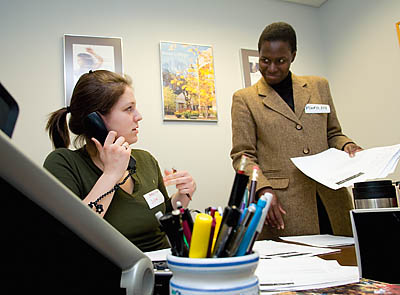A Bridge to Bates
One kind of progress at Bates is eye-catching, what with that 180-foot crane looming over the new Commons next to Garcelon Field and, across campus at the new student housing, sky-blue weather barrier outlining all the windows and doors. But another kind of transformational and intense work — to increase diversity in racial, ethnic, and socioeconomic enrollments — tends to manifest itself in less conspicuous ways.

Julie Wagner ’09 places a phone call to a prospective Bates student as Director of Multicultural Recruitment Marlyn Scott looks on. Wagner was one of the eight Bates students who spent the evening giving support and advice to students going through the financial-aid process.
Take the fledgling program developed by Bates’ admissions and financial aid offices. On a recent February evening, eight Bates students, backed by six staff members, took to the phones in Lindholm House to contact a segment of the current applicant pool: multicultural students and first-generation college aspirants who intend to apply for financial aid but who’ve not yet submitted the required paperwork (FAFSA form, CSS profile, and tax returns).
Armed with FAQs and other information, the Bates students offered support and advice to the applicants, whose hometowns ranged from Presque Isle to Los Angeles. “This is a friendly call,” Catherine Ganung, interim director of student financial services, reminds the students. “It’s about making a bridge to Bates.”
A little past 6, Liz Greenwood ’07 phones a student who lives in a working-class Boston neighborhood. Reaching the student’s Spanish-speaking grandmother, Greenwood deftly shifts to that language, honed during a semester in Seville. Leaving a message, Greenwood heads to a nearby computer. “I need the Spanish word for ‘financial aid,’” she says. After a brief Web search, she finds beca, meaning “scholarship.” Greenwood calls back later in the evening and chats with the student, learning that the girl’s parents don’t live with her, thus filling out the complex documents will be daunting. Greenwood informs Wendy Glass of the Bates financial-aid staff, who makes a note to follow up.
Understanding each family’s financial-aid situation is a Bates hallmark, and that means taking into account a range of family customs and circumstances when it comes to money, says Director of Multicultural Recruitment Marylyn Scott, who has done doctoral work in multilingual and multicultural education. In some families, it’s not acceptable for a child to broach the topic of family finances, even for the purpose of applying for financial aid. “We’re working with such a family now, in the Southwest. The student is one of our top recruits, and we’re hoping his parents decide to file the forms,” says Scott.
While Bates has a longstanding, humane practice of helping any family to navigate the financial-aid process, some families, regardless of demographic, remain unaware of how need-based aid programs work — hence the phonathon in Lindholm House.
And if a family does not fill out the forms in time, Bates will still mail an acceptance letter on March 31 — it just won’t be a thick envelope with the financial aid award inside. This happens about 150 times each year, and while these families remain eligible to receive aid, College officials worry that when a family doesn’t know their financial-aid award right away, they’re liable to be scared off by the $45,000 sticker price. “In fact, some of these families are eligible to have the full cost met by need-based aid,” says Scott.
Unlike the daily progress seen in campus construction projects, it will be months before Bates knows the good results of that evening’s work (191 phone calls, 70 student contacts, 43 contacts with a family member, 69 messages left, seven no-answers, and two out-of-service numbers). The same goes for other emerging initiatives in admissions to identify, recruit, and matriculate talented students of limited means.
One such tack to raise Bates’ visibility is to partner with certain high-achieving secondary schools, and a new example is Bates’ affiliation with the public Urban Assembly School for Law and Justice in Brooklyn. Scott visits the school monthly to conduct admissions sessions, and some 20 Urban Assembly sophomores will visit Bates in May. “There are highly motivated, high-need students out there,” says Ganung. “But as is often said, they will typically know about two colleges: Harvard and their state school.”
The drive to improve Bates’ demographic palette coalesced in 2005–06 with the Campus Climate Project, a faculty-staff-student endeavor convened by President Hansen. The report concluded that in the broad realm of diversity and campus life, Bates was falling short of its founding ideals.
In response, Bates has begun moving ahead on many diversity fronts. Admissions is just one area, because although recruiting and enrolling students by definition focuses on numbers, the College’s redeployment of resources around diversity hopes to move beyond simply counting faces.
“At any institution, structures of unequal power — around race, ethnicity, gender, class, and sexuality — are bred into the bones. Even a place with abolitionist roots, like Bates, suffers from those flaws,” notes Sue Houchins, an associate professor of African American studies since 2003 and now in her first year as President Hansen’s special assistant for diversity. “So if our mission is truly to ‘diversify’ our community, then we must be vigilant in discerning every place that these structures exist.”
Houchins talks about how Bates might adopt an attentive and mindful approach to the issue. “A Carmelite monk, Brother Lawrence, once wrote about how one could keep a certain kind of spiritual mind,” she says. One would practice and deliberately cultivate a state of mindfulness until a desired habit took hold.
“It is that kind of practice of being mindful that, I think, we need at Bates,” says Houchins, who was herself in the novitiate of Carmelite Monastery of Baltimore in the 1990s before returning to academe. “One has to be mindful of diversity, and that habit is very difficult to develop.”